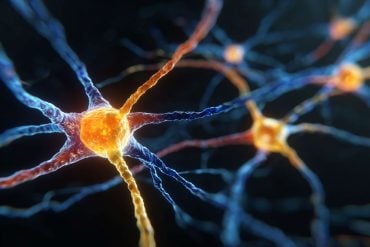Summary: Researchers shed light on the role of astrocytes, a type of brain cell, in olfactory perception or smell detection.
The research reveals that during olfactory stimulation, serotonin transporter Slc22a3 in astrocytes mediates serotonin transport into the cells, influencing gene expression. This process contributes to the production of the neurotransmitter GABA, a crucial component in the neural circuit for sensory perception.
The findings highlight the critical role of astrocytes in sensory processing and animal behavior.
Key Facts:
- Olfactory stimulation leads to an increase of serotonin transporter Slc22a3 in astrocytes, enabling serotonin transport into the cells.
- Once inside the astrocytes, serotonin binds to histones, proteins attached to the DNA, which control gene expression. This process influences the production of neurotransmitter GABA.
- The findings emphasize the plasticity of astrocytes and their ability to change their characteristics and functions in response to environmental stimuli, playing a pivotal role in sensory processing and behavior.
Source: Baylor College of Medicine
To enjoy the scent of morning coffee and freshly baked cookies or to perceive the warning smell of something burning, the brain needs two types of cells, neurons and astrocytes, to work closely with each other.
Research has shown a great deal of the changes that occur in neurons during olfactory, or smell, perception, but what are the astrocyte responses and how they contribute to the sensory experience remains unclear.
Researchers at Baylor College of Medicine and collaborating institutions report in the journal Science the responses of astrocytes to olfactory stimulation, revealing a new mechanism that is required to maintain astrocyte-neuron communication and process olfactory sensation.

“Previous studies have shown that under natural conditions in a living animal, olfactory stimulation of the brain activates neurons first, which changes the genes these neurons express to be able to mediate the olfactory sensation,” said first author Dr. Debosmita Sardar, a postdoctoral associate in Dr. Benjamin Deneen’s lab at Baylor.
“In this study, we investigated what occurred to astrocytes following neural activity during olfactory stimulation and uncovered changes that had not been described before.”
Olfactory stimulation triggered an increase of serotonin transporter Slc22a3 on the astrocytes, which mediated serotonin transport into the cells.
“We followed serotonin inside the astrocytes and were surprised to discover that it traveled to the cell nucleus, where it bound to histones, proteins attached to the DNA that help regulate astrocyte gene expression,” Sardar said.
“Serotonin bound to DNA acted as a switch, which controlled gene expression.”
Interestingly, serotonin regulates the expression of astrocyte genes involved in the production of the neurotransmitter GABA, which then feeds back to neurons regulating the neural circuit fundamental to sensory perception.
“We showed that losing transporter Slc22a3 in astrocytes reduced serotonin levels in the cells and led to alterations in serotonin-bound DNA,” Sardar said.
“In turn, this reduced the expression of genes involved in the synthesis of GABA and decreased astrocytic GABA release, which disturbed the neural circuits of olfactory sensation.”
Serotonin is well known for its contribution to normal brain function as well as being involved in addiction and depression.
“Here we discovered a new function of serotonin in astrocytes. Serotonin triggers changes in astrocyte gene expression patterns, turning astrocytes into a hub of olfactory sensation processing,” Sardar said.
“This project has uncovered novel aspects of astrocyte function,” said Deneen, professor and Dr. Russell J. and Marian K. Blattner Chair in the Department of Neurosurgery and director of the Center for Cancer Neuroscience at Baylor. He also is the corresponding author of the work.
“We are learning that astrocytes are very plastic, just as neurons are, meaning that astrocytes can change their characteristics and functions in response to environmental stimuli. They listen to neurons and respond, and their two-way communication is at the core of sensory processing and ultimately, animal behavior.”
About this olfactory perception and neuroscience research news
Author: Debosmita Sardar
Source: Baylor College of Medicine
Contact: Debosmita Sardar – Baylor College of Medicine
Image: The image is credited to Neuroscience News
Original Research: Closed access.
“Induction of astrocytic Slc22a3 regulates sensory processing through histone serotonylation” by Debosmita Sardar et al. Science
Abstract
Induction of astrocytic Slc22a3 regulates sensory processing through histone serotonylation
Neuronal activity drives alterations in gene expression within neurons, yet how it directs transcriptional and epigenomic changes in neighboring astrocytes in functioning circuits is unknown.
We found that neuronal activity induces widespread transcriptional up-regulation and down-regulation in astrocytes, highlighted by the identification of Slc22a3 as an activity-inducible astrocyte gene that encodes neuromodulator transporter Slc22a3 and regulates sensory processing in the mouse olfactory bulb.
Loss of astrocytic Slc22a3 reduced serotonin levels in astrocytes, leading to alterations in histone serotonylation. Inhibition of histone serotonylation in astrocytes reduced the expression of γ-aminobutyric acid (GABA) biosynthetic genes and GABA release, culminating in olfactory deficits.
Our study reveals that neuronal activity orchestrates transcriptional and epigenomic responses in astrocytes while illustrating new mechanisms for how astrocytes process neuromodulatory input to gate neurotransmitter release for sensory processing.







